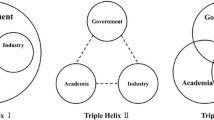Abstract
Technological environments provide multiple conditions for the development of technology-based business and intellectual properties. Over the last decades, the Chilean government has designed/implemented a technology, innovation, and entrepreneurship policy framework. This chapter analyzes the technology transfer policy framework’s evolutionary process and its effectiveness. This chapter adopts a retrospective longitudinal analysis. Our findings provide some insights into the outcomes and challenges regarding technology transfer practices in Chile.
Access this chapter
Tax calculation will be finalised at checkout
Purchases are for personal use only
Similar content being viewed by others
References
Audretsch, D., & Link, A. (2012). Entrepreneurship and innovation: Public policy frameworks. The Journal of Technology Transfer, 37(1), 1–17.
Autio, E., Kenney, M., Mustar, P., Siegel, D., & Wright, M. (2014). Entrepreneurial innovation: The importance of context. Research Policy, 43(7), 1097–1108.
Bercovitz, J., & Feldman, M. (2006). Entrepreneurial universities and technology transfer: A conceptual framework for understanding knowledge-based economic development. The Journal of Technology Transfer, 31(1), 175–188.
Corporación de Fomento de la Producción CORFO. (2019). Transferencia Tecnológica en Chile: “Estudio de caracterización de las actividades y resultados de los procesos de transferencia tecnológica desde los centros de conocimiento en Chile.” Santiago de Chile.
Decter, M., Bennett, D., & Leseure, M. (2007). University to business technology transfer—UK and USA comparisons. Technovation, 27(3), 145–155.
Gopalakrishnan, S., & Santoro, M. (2004). Distinguishing between knowledge transfer and technology transfer activities: The role of key organizational factors. IEEE Transactions on Engineering Management, 51(1), 57–69.
Gotkin, J. (2012). The United States Bayh-Dole Act and its effect on university technology transfer. Baden-Baden: Nomos Verlagsgesellschaft mbH & Co. KG.
Guerrero, M., Cunningham, J. A., & Urbano, D. (2015). Economic impact of entrepreneurial universities’ activities: An exploratory study of the United Kingdom. Research Policy, 44(3), 748–764.
Guerrero, M., & Urbano, D. (2019). Effectiveness of technology transfer policies and legislation in fostering entrepreneurial innovations across continents: an overview. The Journal of Technology Transfer, 44(5), 1347–1366.
Instituto Nacional de Propiedad Intelectual INAPI. (2020). Propiedad Intelectual e Industrial. Retrieved from Instituto Nacional de Propiedad Intelectual. https://www.inapi.cl/propiedad-intelectual-e-industrial.
Kochenkova, A., Giuri, P., Grimaldi, R., & Munari, F. (2015). The effect of university-level support policies on female participation in academic patenting. Paper presened at the Druid15 Conference. https://conference.druid.dk/acc_papers/4x015n6flh5aoadklvf27tmfut8m.pdf.
Leonard-Barton, D. (1990). A dual methodology for case studies: Synergistic use of a longitudinal single site with replicated multiple sites. Organization Science, 1(3), 248–266.
Lin, Z., & Li, W. (2011). Technological innovation ability of normal universities from authorization of patents and transference of patents in China. Taking South China Normal University as an example. Technology and Innovation Management, 2.
Ministry of Science. (2020). Caracterización de los participantes de la Transferencia Tecnológica en Chile. Retrieved from http://ctie.economia.cl/wp-content/uploads/2020/01/20200110-Boletin-transferencia-tecnológica-1.pdf.
Mitchell, R., & Boyle, B. (2010). Knowledge creation measurement methods. Journal of Knowledge Management, 14(1), 67–82, Q Emerald Group Publishing Limited, ISSN 1367-3270.
Mowery, D., & Oxley, J. (1995). Inward technology transfer and competitiveness: The role of national innovation systems. Cambridge Journal of Economics, 19(1), 67–93.
Munari, F., Sobrero, M., & Toschi, L. (2018). The university as a venture capitalist? Gap funding instruments for technology transfer. Technological Forecasting and Social Change, 127, 70–84.
Organization for Economic Cooperation and Development OECD. (2003). Organisations, turning science into Business: Patenting and licensing at public research. Retrieved from https://www.oecd-ilibrary.org/.
Ramachandran, V. (1993). Technology transfer, firm ownership, and investment in human capital. The Review of Economics and Statistics, 75, 664–670.
Roessner, J. (2000). Technology transfer. In Science and technology policy in the US. A time of change. London: Longman.
Rogers, E., Takegami, S., & Yin, J. (2001). Lessons learned about technology transfer. Technovation, 21(4), 253–261.
Steffensen, M., Rogers, E., & Speakman, K. (2000). Spin-offs from research centers at a research university. Journal of Business Venturing, 15(1), 93–111.
World Intellectual Property Organization WIPO. (2020). The patent cooperation treaty statistics. https://www.wipo.int/edocs/infogdocs/en/ipfactsandfigures2019/.
Wright, M., Birley, S., & Mosey, S. (2004). Entrepreneurship and university technology transfer. The Journal of Technology Transfer, 29(3–4), 235–246.
Yin, R. (2017). Case study research and applications: Design and methods. London: Sage Publications.
Acknowledgments
Claudia Yáñez-Valdés acknowledges the financial support provided by the Universidad del Desarrollo. Maribel Guerrero acknowledges the Facultad de Economía y Negocios at the Universidad del Desarrollo (Chile), the Northumbria Centre for Innovation, Regional Transformation and Entrepreneurship based on Newcastle Business School at Northumbria University (UK), and the Centre for Innovation Research (CIRCLE) at Lund University (SE) for their invaluable support.
Author information
Authors and Affiliations
Corresponding author
Editor information
Editors and Affiliations
Rights and permissions
Copyright information
© 2021 The Author(s), under exclusive license to Springer Nature Switzerland AG
About this chapter
Cite this chapter
Yáñez-Valdés, C., Guerrero, M. (2021). Technology Transfer Policy Framework in Chile. In: Guerrero, M., Urbano, D. (eds) Technology Transfer and Entrepreneurial Innovations. International Studies in Entrepreneurship, vol 51. Springer, Cham. https://doi.org/10.1007/978-3-030-70022-5_6
Download citation
DOI: https://doi.org/10.1007/978-3-030-70022-5_6
Published:
Publisher Name: Springer, Cham
Print ISBN: 978-3-030-70021-8
Online ISBN: 978-3-030-70022-5
eBook Packages: Business and ManagementBusiness and Management (R0)




